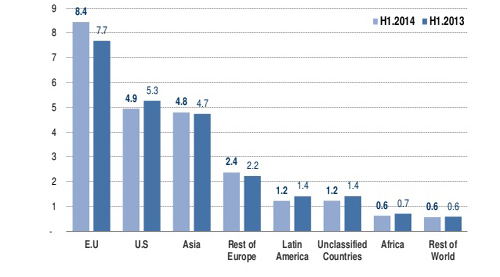SUMMARY
Spot ethylene and propylene appeared to find a price floor and traded steady to slightly higher, while NGLs and energy were mixed. Benzene prices continued their swift ascent. Resins activity picked up with the return of export opportunities and spot prices began to see small gains.
OLEFINS
Spot ethylene prices traded higher this week for March and April. March traded at 23.75 cpp and 24.5 cpp. A week earlier, front-month ethylene traded at 23 cpp. April traded early in the week in the 23.25-23.75 cpp range, and traded Wednesday at 24.125 cpp. More than 150 million pounds of forward ethylene traded on an ethane formula basis this week stretching out through December 2009. So far in March, more than 500 million pounds of spot ethylene has transacted.
Propylene traded several times this week, in familiar territory. Ten refinery grade propylene deals were confirmed for delivery via several modes in March and April in the 19-20.5 cpp range. Polymer grade propylene traded twice at 25.5 cpp for April and once for March at 26.1 cpp. No chemical grade propylene deals were confirmed. RGP’s implied alky values remained up to 10 cpp above spot RGP prices in the Gulf this week. RGP’s implied cumene value was 3-4 cents below its spot price early in the week, but rose to about a 1-cent discount to spot RGP at week’s end.
In the propylene contract markets, nominations were heard for April polymer and chemical grade propylene at a 1-cent increase and a 3-cent increase.
The state of supply was a hot topic in this week’s market. Westlake’s Petro 1 cracker returned to operation on March 21, after going down Dec 17 for maintenance. MarkWest’s Javelina facility is scheduled to restart March 31 and Shell’s GO-1 unit is expected to restart during the second half of April. A complete list of the remaining outages is attached as a separate PDF.
LyondellBasell said this week it will permanently close its Chocolate Bayou olefins complex by Aug 4. The plant was shut in mid-December. The idling of the Chocolate Bayou cracker reduces LyondellBasell’s ethylene capacity in Texas to slightly more than 7 billion pounds per year. LyondellBasell still produces nearly 13% of the total ethylene capacity in the Gulf coast and about 17% of Texas capacity. Eight ethylene production units are currently shut in the Gulf Coast, which represents 12.5% of Gulf coast ethylene capacity, or 7.2 billion pounds per year. At the end of 2008, 27% of Gulf Coast ethylene capacity was shut.
POLYETHYLENE
Spot polyethylene trading started the week slow, but activity picked up as the week progressed with spot monomer prices rebounding and a pronounced increase in resin export activity to China. Domestic PE supplies were limited and prices were mostly steady or slightly higher after losing ground the previous week.
Trading was stifled early in the week as processors continued to move away from the market. Buyers lowered their bids, while traders mostly kept offers at last week’s levels. Although much of the surplus warehoused material was no longer seen offered to this week’s market, some traders with lingering stocks continued efforts to liquidate and found willing buyers.
Producers had been seeking a 5-cent increase in March PE contracts this month. Several market participants said this has been pushed out to April and that contract pricing is flat this month. This came amid a fall of about 10 cents in ethylene monomer spot prices during the first half of March and ongoing worries about weak resin demand. At least one PE producer opted to keep LLDPE prices steady to March while still pursuing the increase HDPE and LDPE resins, but this situation did not appear to be widespread.
After falling a few cents last week, spot PE prices stabilized and some ticked slightly higher as some of the excess inventory was worked out of the system and material became increasingly tougher to source. Processors have continued to buy lower volumes of spot material as needed this week as they have maintained lean inventories due to broad market weakness. Also, as contract prices reportedly held steady this month, some have come into the secondary spot market to source additional resin requirements as a buffer against renewed price increase efforts in April.
Generic prime railcars of HDPE blow mold and HDPE injection ticked up a half-cent early in the week, and LLDPE film butene was flat, all trading in the low 40s cpp range. HMW HDPE film was trading in the low-to-mid 40s cpp. LDPE film was in the high 40s cpp to low 50s cpp range. Some discounted railcars of offgrade material were said to be available at the end of the week as some resellers had a few unsold cars to ship before the end of the month.
The Plastics Exchange spot trading floor had about 2.5-3.5 million pounds of LDPE film offered each day this week. About 2.5 million pounds of LLDPE film was offered each day and about 2 million pounds of HDPE blow mold. Overall spot supplies were considered to be on the light side.
Traders continued to inquire for material for export this week. Demand from Mexican and South America traders appeared typical, while Chinese demand was strong. The increased export activity has allowed some to liquidate remaining inventories that otherwise may have been tough to move in the slow domestic environment, and inspired speculation that supplies could be snug as April begins.
POLYPROPYLENE
Spot polypropylene prices were slightly higher this week as propylene monomer was largely steady and resin supplies continued to tighten due to a swift increase in export activity. Although domestic demand is sluggish, resin throughout the PP supply chain is tight, and the market was generally reported to be considered balanced.
PP contracts in March increased about a penny in line with a 1-cent increase in polymer grade propylene monomer prices. With poor downstream demand, PP producers have been unable to expand contract margins significantly. The difficult environment has prompted the rationing of supply through the idling of lines, keeping operating rates around 80% during the 1Q 2009.
After coming under downward pressure the previous two weeks, spot prices ticked higher as resellers’ warehoused inventories have dwindled. Processor inventories are also slim, prompting their spot demand on an as needed basis. However, for the first time this year, certain grades have become difficult to source in the spot market, even demanding premium prices if available.
Generic prime railcars of polypropylene were mostly priced in the mid 30s cpp range this week, with the lower end of that range more reflective of FOB Houston warehouse prices, and the higher end reflective of delivered US domestic prices, traders said. CoPP has maintained a premium of 1.5 cpp to 2 cpp over HoPP, trading in the mid-high 30s cpp. Offgrde railcars were priced at a typical 2-3 cpp discount.
Overall spot supplies are considered light and The Plastics Exchange spot trading floor had only about 2 million pounds of HoPP and CoPP offered each day this week.
Exports continued to move swiftly from the US. Most of the demand was seen from South America and Mexico, particularly for commodity injection grade material and particularly for raffia/fiber grade. The increased export activity has started to affect the domestic market, traders said. The alternative demand has helped supplies move much of the region’s surplus material, while producers seem to be allocating some April reactor time for export resin availability.
POLYSTYRENE
After an extended period of falling prices, spot polystryene prices rose this week. The market is supported by snug spot supplies and rising benzene prices. <
br />
Spot GPPS was available in the mid-to-high 40s cpp range, with offcolor material priced at a discount. HIPS offers were in the low-to-mid 50s cpp range. Prices were up 1-2 cpp.
The Plastics Exchange spot trading floor had about 700,000 pounds of GPPS offered this week and about 1 million pounds of HIPS on offer.
BENZENE
Spot prices continued to rise this week. March trading was largely done and April moved into the spot light. April closed Monday at 153-154 cpg DDP, at 160-162 cpg DDP Wednesday and closed the week at 169-172 cpg DDP.
Benzene has been supported by robust export demand for styrene and also renewed interest in domestic cumene from the gasoline community.
Initial agreements were heard this week for April benzene contracts, at 170 cpg, but this was not considered to be marketwide. March benzene settled at 129 cpg, a level which spot prices surpassed on March 12.
NGLs
Ethane: Prices were slightly lower this week. Markets closed at 35.5 cpg on Monday and at 34 on Wednesday before ending the week at 32.25 cpg. Ethane closed last week at 34.25 cpg. Ethane has remained popular feedstock, cracker operators said. Ethane’s forward curve held its mild contango shape. At the close of the week, Sep 2009 closed at 34 cpg and Mar 2010 closed at 36.625 cpg.
Propane: Prices fell this week. Propane closed at 74.75 cpg Monday, at 71.25 cpg Wednesday and closed the week at 68.125 cpg, compared with 72 cpg the previous Friday. Propane/propylene inventories increased last week by 0.6 million barrels and are above the upper limit of the average range, the EIA reported Wednesday.
Butane: Prices were up during the week but ended it flat. Butane closed Monday 91.25 cpg, and at 88.25 cpg on Wednesday. It closed at 87 cpg on Friday, compared with 87 cpg the previous Friday. Isobutane’s premium to normal butane widened from 9 cpg to 15 cpg, supported by demand for its use in alkylate production. Butane remained a relatively expensive feedstock and cracker operators avoided it where possible.
Natural gasoline: Prices remained above $1/gal this week, recording mild gains. Natural gasoline closed at 110 cpg Monday, at 107 cpg Wednesday and ended the week at 108.75 cpg, compared with 104.55 cpg the previous Friday. Natural gasoline has once again become an unprofitable feedstock fo steam crackers.
ENERGY
Crude oil futures saw slight gains on the week, remaining above $50/bbl. May crude moved into the front-month contract position on Monday, closing at $53.80/bbl that day. It settled at $52.77/bbl Wednesday and ended the week at $52.38/bbl, compared with $52.07/bbl the previous Friday. April contract expired Mar 20 at $51.06/bbl.
US crude oil refinery inputs averaged 14.1 million barrels per day during the week ending March 20, the EIA reported Wednesday, down 45,000 barrels per day from the previous week’s average. Refineries operated at 82% of their operable capacity last week, nearly unchanged from the previous week’s rate of 82.1%. Gasoline production fell last week, averaging 8.7 million barrels per day.
Natural gas prices were down dramatically this week. April nat gas futures settled at $$4.294/mmBtu Monday and at $4.295/mmBtu Wednesday. April closed at $3.631//mmBtu Friday, compared with $4.227/mmBtu the previous Friday.
Working gas in storage was 1,654 Bcf as of Friday, March 20, according to EIA estimates released Thursday. This represents a net increase of 3 Bcf from the previous week. Stocks were 372 Bcf higher than last year at this time and 280 Bcf above the 5-year average of 1,374 Bcf.
Source: petrochemwire.com







